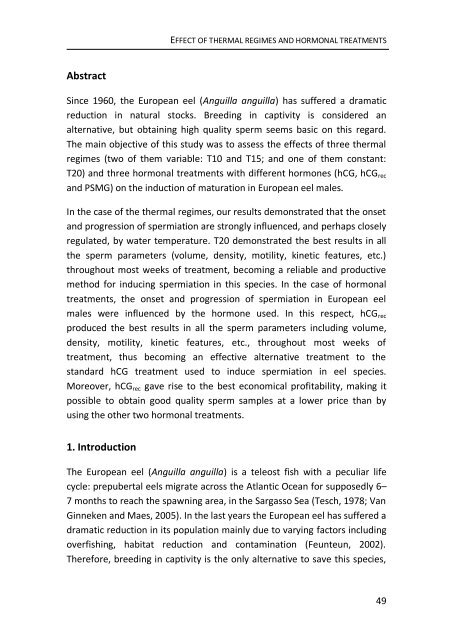chapter 3 - RiuNet
chapter 3 - RiuNet
chapter 3 - RiuNet
Create successful ePaper yourself
Turn your PDF publications into a flip-book with our unique Google optimized e-Paper software.
EFFECT OF THERMAL REGIMES AND HORMONAL TREATMENTS<br />
Abstract<br />
Since 1960, the European eel (Anguilla anguilla) has suffered a dramatic<br />
reduction in natural stocks. Breeding in captivity is considered an<br />
alternative, but obtaining high quality sperm seems basic on this regard.<br />
The main objective of this study was to assess the effects of three thermal<br />
regimes (two of them variable: T10 and T15; and one of them constant:<br />
T20) and three hormonal treatments with different hormones (hCG, hCG rec<br />
and PSMG) on the induction of maturation in European eel males.<br />
In the case of the thermal regimes, our results demonstrated that the onset<br />
and progression of spermiation are strongly influenced, and perhaps closely<br />
regulated, by water temperature. T20 demonstrated the best results in all<br />
the sperm parameters (volume, density, motility, kinetic features, etc.)<br />
throughout most weeks of treatment, becoming a reliable and productive<br />
method for inducing spermiation in this species. In the case of hormonal<br />
treatments, the onset and progression of spermiation in European eel<br />
males were influenced by the hormone used. In this respect, hCG rec<br />
produced the best results in all the sperm parameters including volume,<br />
density, motility, kinetic features, etc., throughout most weeks of<br />
treatment, thus becoming an effective alternative treatment to the<br />
standard hCG treatment used to induce spermiation in eel species.<br />
Moreover, hCG rec gave rise to the best economical profitability, making it<br />
possible to obtain good quality sperm samples at a lower price than by<br />
using the other two hormonal treatments.<br />
1. Introduction<br />
The European eel (Anguilla anguilla) is a teleost fish with a peculiar life<br />
cycle: prepubertal eels migrate across the Atlantic Ocean for supposedly 6–<br />
7 months to reach the spawning area, in the Sargasso Sea (Tesch, 1978; Van<br />
Ginneken and Maes, 2005). In the last years the European eel has suffered a<br />
dramatic reduction in its population mainly due to varying factors including<br />
overfishing, habitat reduction and contamination (Feunteun, 2002).<br />
Therefore, breeding in captivity is the only alternative to save this species,<br />
49
















